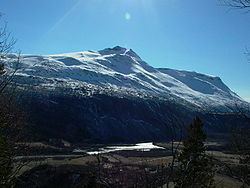Country Norway District Salten Area rank 81 in Norway Area 1,222 km² Local time Thursday 12:53 AM | County Nordland Administrative centre Moldjord Demonym(s) Beiarværing Population 1,097 (2011) Official language form Bokmål | |
 | ||
Weather -6°C, Wind E at 13 km/h, 77% Humidity Points of interest Svartisen, Stranda, Mølen, Leirvika | ||
Beiarn in 4k northern norway dji phantom 3 professional
Beiarn is a municipality in Nordland county, Norway. It is part of the traditional district of Salten. Beiarn is also a part of the Bodø Region, a statistical metropolitan region. The administrative centre of the municipality is the village of Moldjord. Other villages in Beiarn are Høyforsmoen, Trones, and Tverrvika.
Contents
- Beiarn in 4k northern norway dji phantom 3 professional
- Map of Beiarn Norway
- General information
- Name
- Coat of arms
- Churches
- Geography
- Government
- Municipal council
- Attractions
- References
Map of Beiarn, Norway
General information
The municipality of Beiarn was established in 1853 when it was separated from the large municipality of Gildeskål. Initially, Beiarn had 1,164 residents. The municipal boundaries have not changed since that time.
Name
The municipality is named after Beiar Fjord (Old Norse: Beðir or Beðinn). The meaning of the name is not definitively known, but it may be related to the English word bed in the sense of a "river bed". The name was historically spelled Beieren.
Coat-of-arms
The coat-of-arms is from modern times; they were granted in 1988. The arms show a gold-colored pine tree on a green background. This was chosen because of the mighty pine forests for which Beiarn has historically been well-known.
Churches
The Church of Norway has one parish (sokn) within the municipality of Beiarn. It is part of the Salten deanery in the Diocese of Sør-Hålogaland.
A privately owned stave church was built in 2006 at Savjord, about 8 kilometres (5.0 mi) east of Moldjord. The Savjord Stave Church was modeled after the Gol Stave Church.
Geography
The municipality of Beiarn is located just north of the Arctic Circle, along the Beiar River including the Beiar Valley and some surrounding areas in the Saltfjellet mountains. The river is one of the best salmon rivers in Northern Norway. There are several large lakes in Beiarn including Arstaddalsdammen, Litle Sokumvatnet, and Ramsgjelvatnet.
The Saltfjellet–Svartisen National Park is partially located in Beiarn. The world's most northern naturally occurring elm forest (Ulmus glabra) grows in the Arstadlia nature reserve, where the rich vegetation also includes orchids.
Government
All municipalities in Norway, including Beiarn, are responsible for primary education (through 10th grade), outpatient health services, senior citizen services, unemployment and other social services, zoning, economic development, and municipal roads. The municipality is governed by a municipal council of elected representatives, which in turn elect a mayor.
Municipal council
The municipal council (Kommunestyre) of Beiarn is made up of 15 representatives that are elected to every four years. Currently, the party breakdown is as follows:
Attractions
The area offers many outdoor activities to visitors, including fishing, caving, and mountain walking. The Beiarn farm museum includes an overview of Beiarn's cultural history, from the Viking Age through to the middle of the 20th century.
